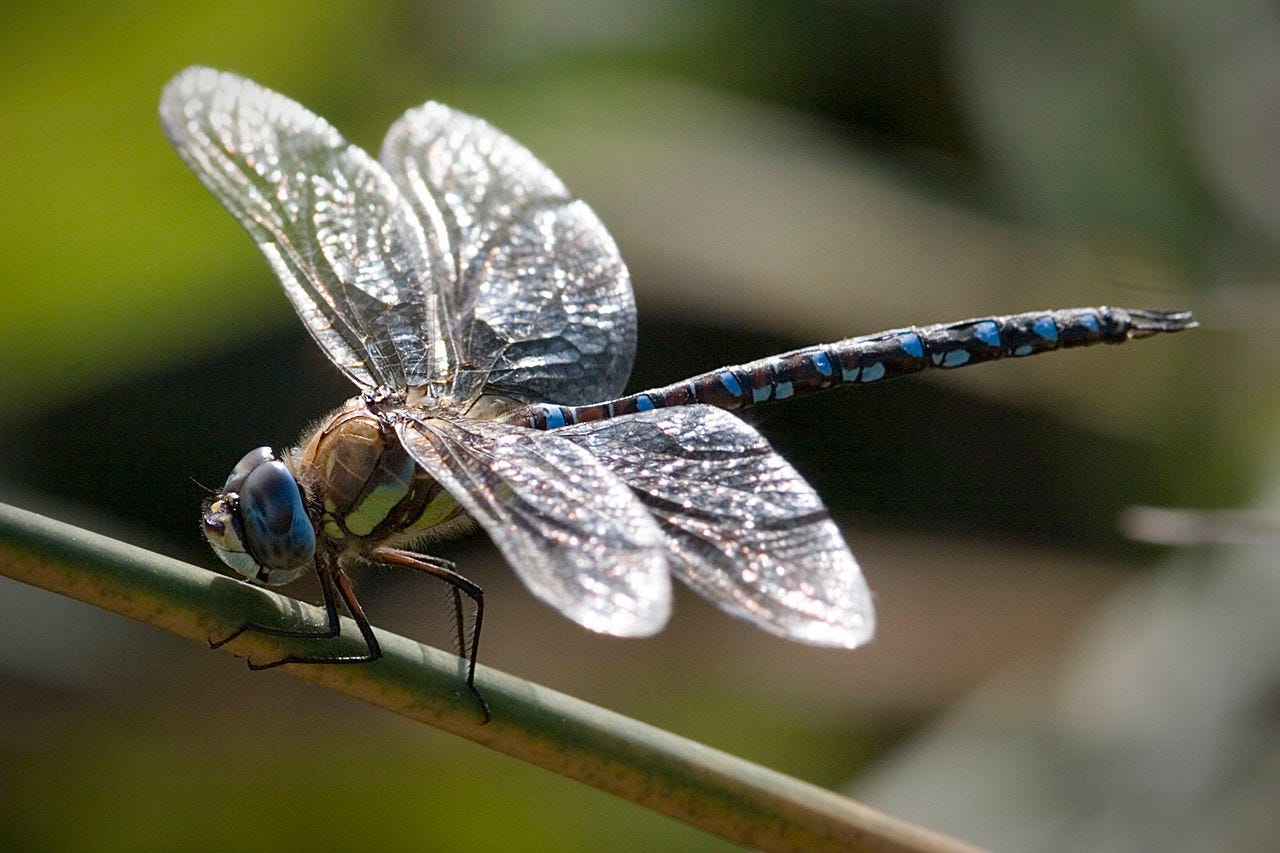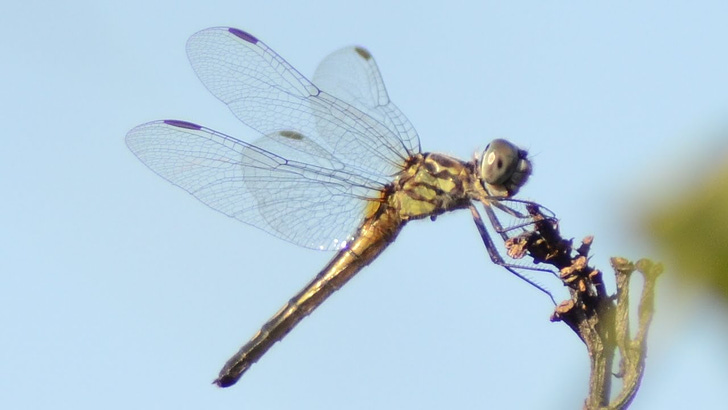Dragonflies -The Dance of Aerial Hunters
Imogen looks at the predatory nature of the humble dragonfly
Recently, during a lunchtime stroll, I had the incredible luck of watching a female dragonfly laying her eggs. Watching her up close, darting in and out of the water in a vertical stance, was incredible. The aerial feat was almost an impossible manoeuvre executed with precision for minutes at a time. It must have been exhausting for the creature. Dragonflies usually lay their eggs in or near water, ensuring their babies, called nymphs, have a safe place to grow. The mother dragonfly taps her abdomen on the water’s surface to release the eggs, which then sink to the bottom or cling to water plants.
Seeing this process up close was a reminder of the importance of even small bodies of water for many creatures to thrive, and how dry spells can really impact creatures that rely on these habitats for survival, upsetting the balance of local ecology.
Among the dragonflies you might see gracing the Highland skies are the Common Hawker (Aeshna juncea) which stands out with its striking blue and yellow markings. This guardian of moorland pools and boggy terrains can often be seen darting through the countryside, its wings a blur of motion as it patrols its watery domain.

The Golden-ringed Dragonfly (Cordulegaster boltonii), a creature of mythic proportions with its bold black and yellow stripes. As the largest dragonfly in the UK, it reigns supreme over streams and rivers, its presence a vivid contrast to its surroundings.

Then there is the metallic green of the Emerald Damselfly which you may see in ditches, the vivid azure and black striped colour of the Common Blue Damselfly and the ruddy coloured Large Red Damselfly which prefers vegetated sites, and is found on a variety of water bodies including rivers and canals.
Dragonflies are unparalleled hunters, their aerial ballet a marvel of natural engineering. With wings that can beat up to 30 times per second, these masters of the sky hover, dart, and weave with seemingly effortless grace.
Dragonflies are possibly the most effective predators on the planet. They employ sophisticated hunting strategies that set them apart from other insect predators. Their precision is enhanced by split-second calculations to determine the best approach angle based on distance, direction, and speed. Rachel Crane, a biologist at UC Davis, and her team studied this in 2023. They created a programmable pulley system to mimic prey movements and filmed the movements of the dragonflies in pursuit. They found that dragonflies consistently fly one metre per second faster than their prey. Dragonflies caught an average of 95% of their prey, Sharks and lions, typically regarded as apex predators, achieve success rates of merely 50% and 25%, respectively.
Additionally, dragonflies adapt their techniques based on prey size: catching smaller insects like mosquitoes directly with their mouths, while trapping larger prey with their legs before consuming it.
Dragonflies are highly adapted hunters, thanks to their specialised anatomy, advanced vision, and rapid flight. Their powerful jaws and spiny legs allow them to capture and immobilise prey efficiently. With compound eyes, they have nearly 360-degree vision, detecting even the slightest movements. Their unique wing structure enables them to fly in any direction, change course instantly, and reach speeds of up to 30 miles per hour. Additionally, dragonflies excel in predictive interception, calculating prey trajectories and intercepting them mid-flight, a skill that even advanced robots struggle to replicate.
The diet of a dragonfly is a testament to its role as nature's pest controller. They excel in swarm navigation, tracking and isolating individual prey within a swarm while avoiding collisions.
In the Highlands, midges are infamous for their swarming, biting presence. Dragonflies, with their agile flight, feast on these tiny tormentors, their efforts a welcome relief to both wildlife and human visitors alike. Flies, mosquitos and even small beetles are not safe from the dragonfly's relentless pursuit. Their versatility as predators ensures a balanced ecosystem, keeping insect populations in check and maintaining the delicate harmony of the Highlands.
Occasionally, the larger dragonflies might take on butterflies and moths, their delicate wings a surprising but not unwelcome addition to the dragonfly's diet. These are rarer catches, but they highlight the adaptability and varied palate of these aerial hunters.
Ways to help Dragonflies!
Bringing the Magic Home
Imagine bringing a touch of this magic to your own doorstep. By adding a small pond to your garden, you can create a haven for these extraordinary creatures, to continue their lifecycle. Not only will you enjoy the mesmerising sight of dragonflies hunting around the water and your garden, but you'll also be contributing to the conservation of these vital predators. A garden pond, with its lily pads and still waters, can become a sanctuary for dragonflies, providing them with a breeding opportunity. So, take a step towards welcoming these dazzling aerial hunters into your life, and let the enchantment inspire your own garden oasis.
Build it, and They Will Come
Have you ever thought about giving a homemade mini pond kit as a birthday present? It’s a great idea that combines the fun of giving gifts with learning about nature. This sort of gift keeps on giving - right in your own garden.
Surveying
Performing dragonfly surveys offers valuable insights into the health and diversity of dragonfly populations at your site, whether it's a nature reserve or a garden pond. Detailed records enhance your understanding of how these populations use your site. By conducting three site visits a year for regular monitoring, you can track changes in dragonfly populations over time and correlate them with habitat conditions and other environmental factors. This ongoing data collection helps you understand how populations respond to habitat management activities, enabling you to adjust your strategies to better support dragonfly species on your site.







Hi Imogen, this is a lovely article that Jackie Wilson on Gairloch and Loch Ewe facebook page and now Caroline Vawdrey of HEF have brought to my attention. Lots of interesting info; I'm a big fan of dragonflies too. However I think the statement about a dragonfly taking 700,000 midges a day is wrong; it may be based on info in the paper reported here . . . https://www.britishecologicalsociety.org/dragonflies-are-efficient-predators-that-consume-hundreds-of-thousands-of-insects-locally/ ?
Might be worth adding a wee correction to the article - or simply removing that bit about 700,000 midges. I sometimes get things like that wrong . . . then correct them when I find out!
Also keen to find out more about what happens to midges and what the top consumers are of adult midges? Very hard to find info . . . George Hendry suggests nematodes; I wonder about hammock web spiders taking midges as they go up or as they come down again? Many thanks again for article. We need more countryside rangers!
“Dragonflies caught an average of 95% of their prey,” that’s a remarkable statistic. I had no idea!